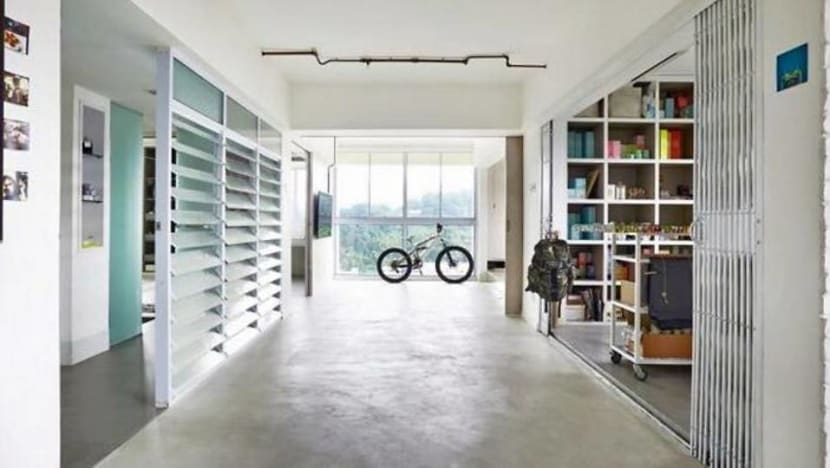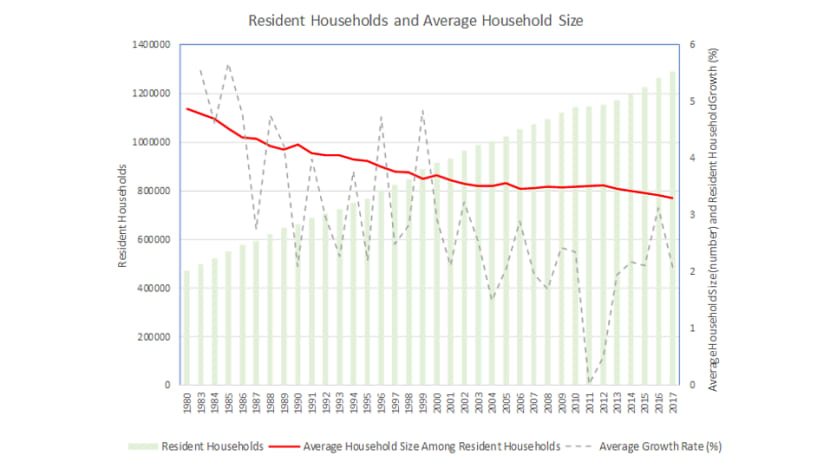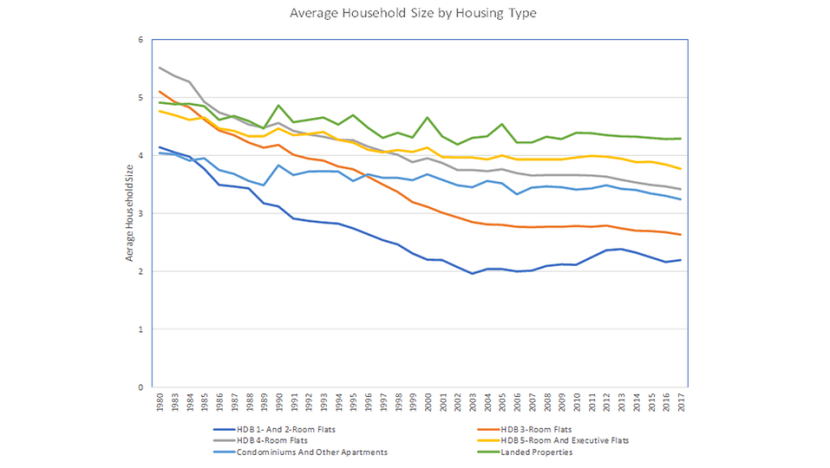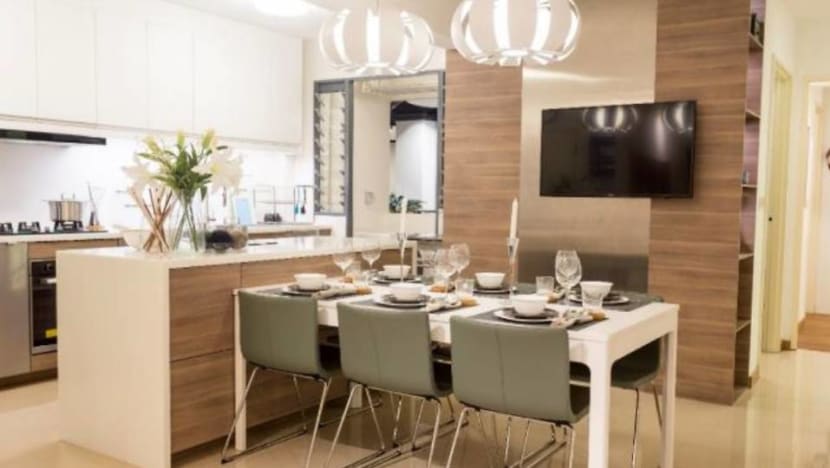commentary Commentary
Commentary: The future of Singapore housing is in bigger HDB flats
Consider building more jumbo flats to encourage young Singaporean couples to live with their aged parents and have kids, says Sing Tien Foo, director of the NUS Institute of Real Estate and Urban Studies.

There are only 485 Jumbo HDB flats in Yishun and Woodlands. (Photo: 99.co)
SINGAPORE: Singapore’s population boom in its first 40 years has seen the massive explosion of households and the mushrooming of public housing to meet residential needs.
The number of resident households has increased by almost three times from 472,700 in 1981 to 1,289,900 in 2017.
However, the rapid growth phases in the 1980s and 1990s with the number of households expanding at an average annual rate of about 4.62 per cent and 3.32 per cent are unlikely to be replicated going forward.
Instead, average household growth rates have slowed down to about 1.79 per cent in the 2010s. Resident household growth rates have stabilised at 2.08 per cent in 2017 after a sharp decline in 2011.

In other words, it’s time for HDB to shift gears from ramping up housing supply to rethinking what sustainable, highly liveable housing that promotes social goals should look like.
SHRINKING HOUSEHOLD SIZES
A second important shift in Singapore’s demographic structure impacting housing has also been underway, where the average household size has significantly decreased from 4.87 persons in 1980 to 3.30 persons in 2017.
We have observed alarming trends in the growth of smaller 2-person and 3-person household families, which collectively make up more than 4 in 10 of total households in Singapore as of 2017.
The changing demographic structure may have implications for the demand for HDB flats, but the causal effects are not as clear. Did HDB and private developers respond to dwindling trends in household size by building smaller flats and private apartments? Or did household sizes shrink because developers built smaller apartments?

It’s clear that private developers had ramped up the supply of shoebox units in response to higher investment demand for smaller and more affordable apartments that can be rented out, prompting URA to revise guidelines to reduce the number of shoebox units and stem the shrinking of private homes in October.
While there is no evidence to suggest that housing supply is influenced by changing household size, what is clear is that household size across all housing types has shrunk since 1980, with possible knock-on effects for social cohesion and family bonding.
Except for landed housing that has an average household size of 4.29 persons, private condominiums and apartments house on average 3.24 persons.
Bigger 4-room and 5-room or executive HDB have an average household size of 3.42 and 3.77 persons respectively, while the smallest of the lot, the 2-room and 3-room HDB flats house 2.19 persons and 2.63 persons respectively.
The average occupancy size for each housing type has also come down but stayed constant since the early 2000s.

BIGGER HOUSES MIGHT ENCOURAGE FAMILIES TO HAVE CHILDREN
While we cannot establish cause, it’s undeniable that the family planning decisions of Singapore households are correlated with the size of housing they live in.
READ: Want more babies? Help couples build stronger marriages first, a commentary
In an earlier op-ed I wrote, I highlighted that three groups of households tend to have more children - homeowners (relative to renters), families living with parents or siblings (usually in a bigger apartment), and families from older cohorts, based on empirical analyses done with two scholars from National Chengchi University using the Panel Study of Family Dynamics survey data from Taiwan.
Why might that be the case for those who live with other immediate family members? If childcare support from old parents were a consideration for younger couples to bring forward their childbearing decisions, housing policies that encourage extended family members to live with each other may create a conducive environment with strong family support that encourages young couples to have more kids and at a younger age.
READ: The Lease Buyback scheme can give singles more housing options, a commentary
IN SINGAPORE, FROM JUMBO FLATS TO 3GEN APARTMENTS
In 1989, where there was an oversupply of flats in some housing estates, including Woodlands and Yishun, HDB took the unprecedented step to combine unsold 3-room and 4-room flats and convert them into jumbo flats of 147 sq m to 199 sq m.
Families living in jumbo flats enjoy the luxury of space afforded by many bedrooms, a huge living and dining area, a family room and a kitchen, even leaving space for a study room and a maid room in some cases.

It’s no wonder then that they are highly sought after by large multi-generation families but one almost cannot plan to own one without some deliberate and well-timed searching and waiting.
With only a few thousand jumbo flats to go around Singapore, they barely register a blip on the total population of HDB flats. Where not many are put on the resale market, they command a high price premium, ranging from S$650,000 to S$950,000.
The jumbo flats were a one-off plan by HDB to clear unsold flats in the 1980s. Such a similar large-scale conversion has not been undertaken by HDB since.
Existing flat owners can still apply to the HDB Conversion Scheme to combine two adjoining 3-room or smaller flats bought in the resale markets. But these are ad hoc and rare, considering also the implication that the two title deeds will be merged and the flats cannot be split up for separate sale subsequently.
Yet perhaps in recognition of the possibility that more young couples want to stay in bigger flats with their ageing parents, the government recently reintroduced multi-generation living and brought back a batch of 84 three-generation (3Gen) flats in the Build-to-Order exercise in November 2013.
READ: A tale of one HDB flat across two generations, a commentary
These flats of at least 115 sq m, which have 5 sq m space more than most 5-room flats, include at least four bedrooms and three bathrooms, and can house married couples with their aged parents.
But they do not have two access doors like some private condominium dual-key units do, suggesting HDB’s intent to guard against attracting buyers intending to rent out part of their flat.
Still they remained popular, with eight in 10 of such units booked, said the HDB in February, where close to 1,500 of these flats across more than 20 projects have been put up for sale alone in 2017.
ENCOURAGE MORE TO LIVE WITH FAMILIES
In a land scarce country like Singapore, large flats brush up against competing land uses but if jumbo flats have knock-on social effects - including promoting multi-generation living, strong family support, more closely knitted families and greater encouragement among younger couples to have more children - that extra 5 sq m space in the 3Gen flats would be aligned with other population goals. It would then be worth considering increasing the supply of such flats.
Already, we know that couples are more likely to live with their parents in 5-room and executive flats.

Practically speaking, bigger flats also offer more space to encourage interactive activities that build family bonding and manage friction that might otherwise arise from having to live together in a smaller space.
Living with parents in these 3Gen flats not only allows more young couples in their thirties to spend more time with their parents, it also helps them muster more support and manage the pressure of juggling between bringing up their children and building their careers.
While there is still no clear evidence to suggest that larger flats could change couples’ decisions on childbearing; at least, they would have no excuse not to take care of their ageing parents.
A move to build more 3Gen flats would also complement the Extended Proximity Housing Grant (PHG) which offers S$20,000 to encourage families to buy resale flats and live in close proximity to their parents.
But government intervention will be needed, where high per square foot housing prices will likely continue to incentivise private developers to build more shoebox apartments to meet financially constrained buyers and investors.
READ: URA guidelines change for new condos: All you need to know
HDB is also not likely to build more 5-room and bigger flats, unless new buyers demand for these.
Still, if housing size, and more specifically, 3Gen flats can address Singapore’s twin demographic problems, bringing young families and aged parents under one roof, and tackling the low fertility rates plaguing Singapore for many years, it’s worth relooking the supply of more 3Gen flats.
Sing Tien Foo is the Dean’s Chair Associate Professor and Director of Institute of Real Estate and Urban Studies (IRES), National University of Singapore.












